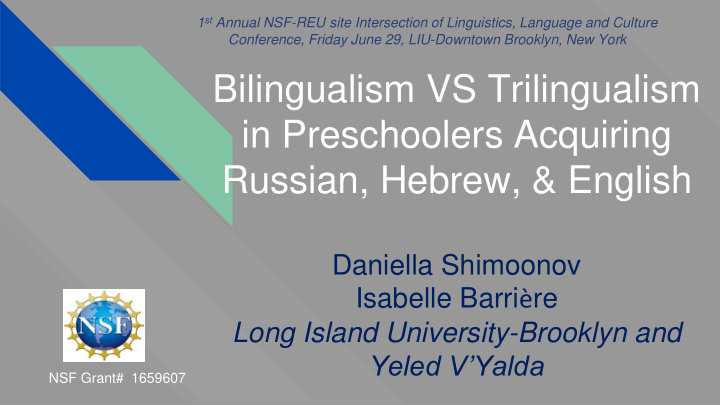



1 st Annual NSF-REU site Intersection of Linguistics, Language and Culture Conference, Friday June 29, LIU-Downtown Brooklyn, New York Bilingualism VS Trilingualism in Preschoolers Acquiring Russian, Hebrew, & English Daniella Shimoonov Isabelle Barri è re Long Island University-Brooklyn and Yeled V’Yalda NSF Grant# 1659607
Languages Other Than English In NYC 3rd Most Spoken 14th Most Spoken Language Other Than Language Other Than English in NYC with English in NYC with 202,225 speakers. 52,424 speakers. Русский תיִרבִע Russian Hebrew Languages Other Than English (LOTE) spoken by New Yorkers over 5 years of age, US Census Bureau (2009) American Community Survey Table B160001 in Garcia, Zakharia & Otcu, 2013, p13.
Key Concepts • Bilingualism – The ability to speak and understand two languages. • Trilingualism – The ability to speak and understand three languages. • Subject-Verb Agreement (SVA) – Sentence structure in which both subject and verb are in accordance in person and number. Examples of Mainstream American English: - the boyØ sleep s - * the boyØ sleepØ • Bootstrapping- Children can acquire the morphosyntax of one language by transferring their knowledge from another language.
Similarities and Differences Across English, Hebrew and Russian Similarity: All 3 languages have overt English: subject. The boys throwØ the toy. The boyØ throws the toy. Differences: ● English has overt marking subject Russian: verb agreement only for 3rd person Mal'chiki brosayut igrushku. singular present. Mal'chikØ brosayet igrushku. ● Russian and Hebrew are overtly marked for person, 1 st , 2 nd , 3 rd Hebrew: singular and plural number and Hayeladim zorkim et hadavar. HayeledØ zorek et hadavar. gender for different tenses.
Background • Cumulative Enhancement Model (Flynn, Foley and Vinnitskaya, 2004): trilingual learners' use all of their languages- L1 and L2- when learning an L3; confirmed on production data focused on relative clauses on Kazakh - Russian- English trilinguals • Versus Other ‘Deficit’ Models: trilinguals at a disadvantage compared to the usual Hebrew-English or Russian-English bilinguals due to them receiving lower amount of input in each individual language.
Research Question Does the Cumulative Enhancement Model apply to comprehension and production in trilingual preschoolers who are simultaneously exposed to Russian (L1 A ) and Hebrew (L1 B ) before being exposed to English (L2)?
First step ● What are the similarities and differences between the comprehension patterns of bilinguals Russian-English and Hebrew – English? ● Doe Russian and Hebrew bootstrap comprehension in English?
Methodology • Parents’ Background Information Questionnaires - % of input in each language Participants (3.5 to 5 year old preschoolers): ● 2 Groups of Bilinguals 17 Russian/L1- English/L2 6 Hebrew/L1- English/L2 ● Trilinguals: ongoing data collection
Comprehension Task Mal’chik Ø chitaet knigu Mal’chik i chitayut knigu
Conditions: English: Russian: Hebrew: Transitive The boys throwØ the toy. Mal'chiki brosayut igrushku. Hayeladim zorkim et hadavar. Real NP The boyØ throws the toy. Mal'chikØ brosayet igrushku. HayeledØ zorek et hadavar. Transitive - - Hem zorkim et hadavar. Real NP Pronouns Hu zorek et hadavar. Transitive The boys throwØ the muk. Mal'chiki brosayut keryag. Hayeladim zorkim et Nonce NP The boyØ throws the muk. Mal'chikØ brosayet keryag. hatechirah. HayeledØ zorek et hatechirah. Transitive - - Hem zorkim et hatechirah. Nonce NP Pronouns Hu zorek et hatechirah. Intransitive Medial The boys sleepØ on the bed. - - PP The boyØ sleeps on the bed. Intransitive Medial The boy s sleep Ø deeply. - - Adverb The boy Ø sleep s deeply. Intransitive Final The boy s sleep Ø . - - The boy Ø sleep s .
Results: Evidence of Comprehension (Mean Sensitivity) by Number and Condition Hebrew Russian 1 1 * ** * 0.9 0.9 0.8 * * * 0.8 SINGULAR Mean Sensitivity 0.7 Mean Sensitivity SINGULAR 0.7 PLURAL 0.6 PLURAL 0.6 0.5 0.5 0.4 0.4 0.3 0.3 0.2 0.2 0.1 0.1 0 0 nonceNP noncePN realNP realPN transnonce transreal
Results: Mean Sensitivity by Number and Condition English for Hebrew English for Russian 1 1 SINGULAR 0.9 0.9 * PLURAL * * * 0.8 0.8 Mean Sensitivity Mean Sensitivity 0.7 0.7 0.6 0.6 0.5 0.5 0.4 SINGULAR 0.4 PLURAL 0.3 0.3 0.2 0.2 0.1 0.1 0 0
Results: English Comprehension by Exposure to English Group English Russian/ 1 Exposure Hebrew 0.9 Exposure * 0.8 Low 10 90 25 75 0.7 Mean Sensitivity Medium 50 50 0.6 High 75 25 0.5 10 90 0.4 0.3 Significant L1 0.2 exposure bootstraps 0.1 bilinguals’ performance 0 high low medium in their L2 English Exposure Group
Conclusions and Significance 1.Examination of bootstrapping from L1 to L2 in preschoolers’ comprehension 2. 50%/50% Exposure advantage: evidence of boostrapping from L1 to L2 3. Russian-English Bilinguals understand a broader range of structures in L2/English than Hebrew-English Bilinguals 4. Cumulative Enhancement Model predicts: Hebrew/L1- Russian/L1-English/L2 trilinguals will comprehend broader range of structures compared to bilingual Hebrew-English ongoing data collection 5. Significance: assessment of bilinguals and trilinguals
Acknowledgments Katsiaryna Aharodnik Nargizakhon Yunusova Michelle Zinger NSF Collaborative Grant Inna Fredericks BCS#1548147 Chana Karp & NSF Grant REU Site Grant Esther Nigri SMA# 1659607 Children, their parents and education professionals at: Yeled V’Yalda Imaginarium Kings Way
Recommend
More recommend